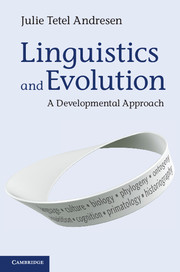Book contents
- Frontmatter
- Contents
- List of Figures
- Introduction Historiography’s contribution to theoretical linguistics
- Part I Theoretical considerations
- 1 Language → languaging
- 2 Developmental systems theory
- 3 A twist in the cognitive turn
- Part II A developmental systems linguistics
- Part III What to do next
- Bibliography
- Name index
- Subject index
3 - A twist in the cognitive turn
Published online by Cambridge University Press: 05 June 2014
- Frontmatter
- Contents
- List of Figures
- Introduction Historiography’s contribution to theoretical linguistics
- Part I Theoretical considerations
- 1 Language → languaging
- 2 Developmental systems theory
- 3 A twist in the cognitive turn
- Part II A developmental systems linguistics
- Part III What to do next
- Bibliography
- Name index
- Subject index
Summary
Adopting a developmental systems approach in linguistics does not mean that everything gets flattened and that we are to dispense with descriptions of either the interior or the exterior. Now, development systems theory does complicate ideas of what and where the boundaries of the interior and exterior are. For instance, a recent study showed that six-month-old babies of women who drank a lot of carrot juice during the last three months of pregnancy preferred cereal made with carrot juice to that made with water. Babies whose mothers had drunk water showed no such preference (Jablonka and Lamb 2005: 162–66). This finding supports other studies that account for the robustness of local/ethnic cuisines by the diet the mother eats when pregnant, which affects the taste preferences of her offspring. Similarly, hearing develops around the fourth month of gestation, and newborns at four days and even earlier can be shown to be attentive to and discriminate between utterances in the native language (the ones they have been hearing for the previous five months) as opposed to a foreign language (Karmiloff and Karmiloff-Smith 2001: 43–46). These studies and others suggest that there is no neat way to divide biology (the traditional interior) from culture (the traditional exterior). They underscore the idea that while the moment of birth is an important one, it is not the point at which the effects of the outside world can be said to begin. Yet these studies do not eliminate the need to understand and describe the interiors and exteriors.
Although the present study wants to press the point that our brains and our bodies have been significantly shaped by human cultural history and that whatever we call mind is not contained within a skull and some skin, it is still nevertheless necessary to have a rich and rigorous way to talk about our interiors. Maturana and Varela’s notion of autopoiesis provides such a way. Not incidentally, for Maturana and Varela, a significant way we humans maintain our autopoiesis is through our languaging together. The purpose of this chapter is to make accessible the thought style in which the term autopoiesis has meaning.
- Type
- Chapter
- Information
- Linguistics and EvolutionA Developmental Approach, pp. 68 - 100Publisher: Cambridge University PressPrint publication year: 2013

